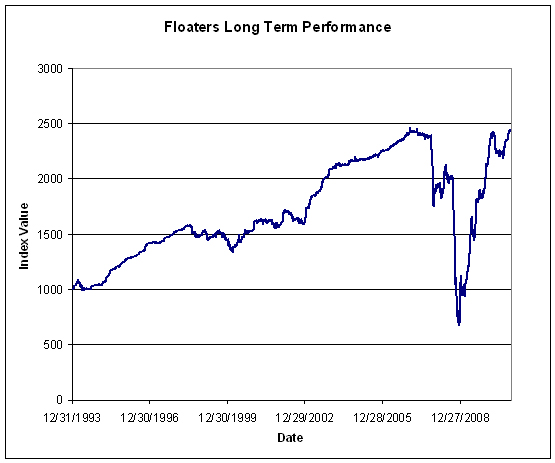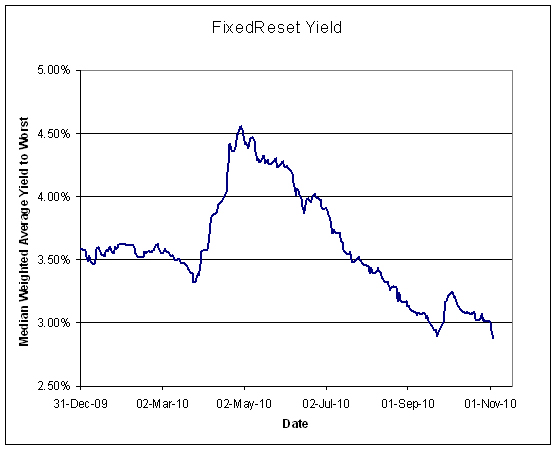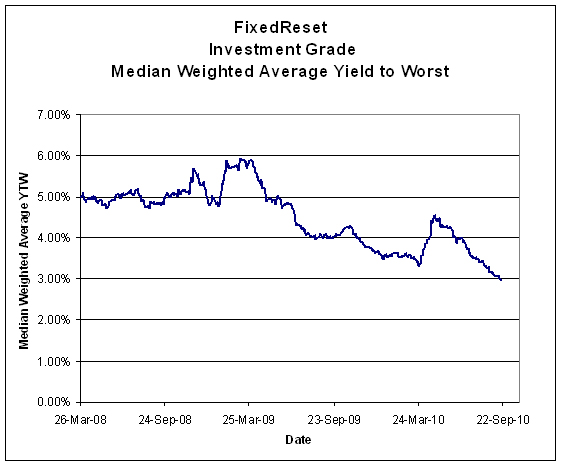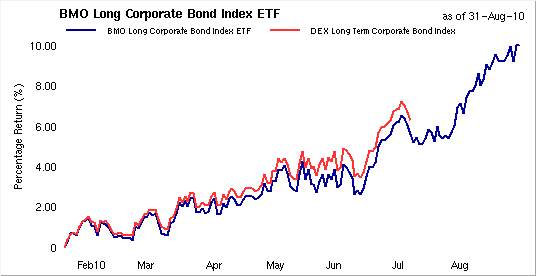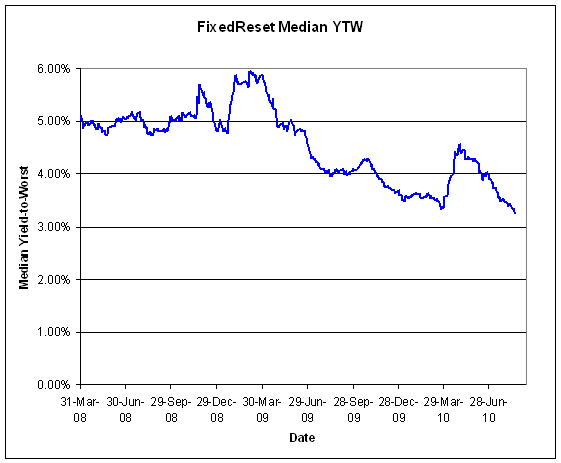Performance of the HIMIPref™ Indices for November, 2010, was:
| Total Return | ||
| Index | Performance November 2010 |
Three Months to November 30, 2010 |
| Ratchet | +3.81% *** | +11.02% *** |
| FixFloat | +5.65% ** | +13.36% ** |
| Floater | +3.48% | +11.02% |
| OpRet | +0.29% | +1.25% |
| SplitShare | +2.98% | +6.79% |
| Interest | +0.29%**** | +1.25%**** |
| PerpetualPremium | -0.32% | +2.01 |
| PerpetualDiscount | +0.71% | +6.91% |
| FixedReset | -0.25% | +0.77% |
| ** The last member of the FixedFloater index was transferred to Scraps at the June, 2010, rebalancing; subsequent performance figures are set equal to the Floater index. The index was repopulated at the October, 2010, rebalancing | ||
| *** The last member of the RatchetRate index was transferred to Scraps at the July, 2010, rebalancing; subsequent performance figures are set equal to the Floater index | ||
| **** The last member of the InterestBearing index was transferred to Scraps at the June, 2009, rebalancing; subsequent performance figures are set equal to the OperatingRetractible index | ||
| Initial index values have been used until I run the precise index computations. Final values are not expected to be materially different | ||
| Passive Funds (see below for calculations) | ||
| CPD | +0.23% | +3.81% |
| DPS.UN | +0.88% | +5.49% |
| Index | ||
| BMO-CM 50 | +0.65% | +5.15% |
| TXPR Total Return | +0.30% | +4.13% |
CPD still has a problem with tracking error – based on its management fee, the monthly tracking error is expected to be 4bp, but this month they came in at 7bp (which was nevertheless an improvement from recent values). The difference may not seem like much, but when these figures are annualized …
The pre-tax interest equivalent spread of PerpetualDiscounts over Long Corporates (which I also refer to as the Seniority Spread) ended the month at 220bp, a significant decline from the 235bp reported at October month end. Long corporate yields increased to 5.4% from 5.2% during the period while PerpetualDiscounts remained constant at 5.41% dividend yield, equivalent to 7.57% interest at the standard conversion factor of 1.4x. I would be happier with long corporates in the 6.00-6.25% range with a seniority spread in the range of 100-150bp, but what do I know? The market has never shown any particular interest in my happiness.
The increase in Long Corporate yields was most pronounced in the first part of the month:
Charts related to the Seniority Spread and the Bozo Spread (PerpetualDiscount Current Yield less FixedReset Current Yield) are published in PrefLetter.
The trailing year returns are starting to look a bit more normal.
Floaters have had a wild ride; the latest decline is presumably due to the idea that the BoC will be slower rather than faster in hiking the overnight rate. I’m going to keep publishing updates of this graph until the one-year trailing return for the sector no longer looks so gigantic:
Volumes are on their way back up Volume may be under-reported due to the influence of Alternative Trading Systems (as discussed in the November PrefLetter), but I am biding my time before incorporating ATS volumes into the calculations, to see if the effect is transient or not.
Compositions of the passive funds were discussed in the September, 2010, edition of PrefLetter.
Claymore has published NAV and distribution data (problems with the page in IE8 can be kludged by using compatibility view) for its exchange traded fund (CPD) and I have derived the following table:
| CPD Return, 1- & 3-month, to November 30, 2010 | ||||
| Date | NAV | Distribution | Return for Sub-Period | Monthly Return |
| August 31 | 16.78 | |||
| September 27 | 17.12 | 0.069 | +2.44% | +2.14% |
| September 30 | 17.07 | -0.29% | ||
| October 26 | 17.21 | 0.069 | +1.22% | +1.40% |
| October 29, 2010 | 17.24 | +0.17% | ||
| November 25 | 17.25 | 0.069 | +0.46% | +0.23% |
| November 30 | 17.21 | -0.23% | Quarterly Return | +3.81% |
Claymore currently holds $582,195,003 (advisor & common combined) in CPD assets, up about $23-million (4.03%) from the $559,641,405 reported at August month-end and up about $208-million (55.78%) from the $373,729,364 reported at year-end. Their tracking error does not seem to be affecting their ability to gather assets!
The DPS.UN NAV for December 1 has been published so we may calculate the approximate November returns.
| DPS.UN NAV Return, November-ish 2010 | ||||
| Date | NAV | Distribution | Return for sub-period | Return for period |
| October 27 | 21.12 | 0.00% | ||
| December 1 | 21.33 | +0.99% | ||
| Estimated October Ending Stub | -0.17% ***** | Estimated December Beginning Stub | * | |
| Estimated November Return | +0.88% ****** | |||
| *CPD had a NAVPU of 16.82 on September 1 and 16.78 on August 31, hence the total return for the period for CPD was +0.24%. The return for DPS.UN in this period is presumed to be equal. | ||||
| **CPD had a NAVPU of 17.21 on November 30 and 17.20 on December 1, therefore the return for the day was -0.06%. The return for DPS.UN in this period is presumed to be equal. | ||||
| *****CPD had a NAVPU of 17.21 on October 27 and 17.24 on October 29, hence the total return for the period for CPD was +0.17%. The return for DPS.UN in this period is presumed to be equal. | ||||
| **** The estimated November return for DPS.UN’s NAV is therefore the product of three period returns, +0.99%, -0.17%, +0.06% to arrive at an estimate for the calendar month of +0.88% | ||||
Now, to see the DPS.UN quarterly NAV approximate return, we refer to the calculations for September & October:
| DPS.UN NAV Returns, three-month-ish to end-November-ish, 2010 | |
| September-ish | +4.39% |
| October-ish | +0.17% |
| November-ish | +0.88% |
| Three-months-ish | +5.49% |
Sentry Select is now publishing performance data for DPS.UN, but this appears to be price-based, rather than NAV-based. I will continue to report NAV-based figures.


